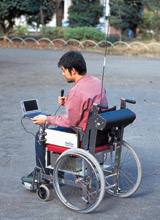STEERING CLEAR OF BUMPS:
New Navigation System to Help Wheelchair Users
February 7, 2001
|
 |
|
Using high-tech to build a wheelchair-friendlier society. (FOR-A Co. Ltd.)
|
Two Tokyo-based companies are spearheading an effort to jointly develop a navigation system for wheelchairs. Like car navigation systems, it will display a route between the user's present position and destination on a screen. Unlike conventional systems, though, it will also provide information important to wheelchair users, such as the presence of slopes, steps, curbs, and other potential obstacles. The collection of data regarding these obstacles will be conducted in Tokyo's Setagaya Ward over a period of about two years, beginning in April 2001. When wheelchair users are able to go out and about without worry, the first step toward a barrier-free society will be realized. The developers are thus working on the project with great enthusiasm.
System Minimizes Obstacles
Video equipment maker For-A has teamed up with Kokusai Kogyo, an engineering consultant firm specializing in geospatial information technology, to develop wheelchairs equipped with a voice-activated IT navigation system. When the user states a destination into a microphone, the computer located under the wheelchair's seat responds by pinpointing the user's present location through the satellite-driven Global Positioning System and displays a wheelchair-passable route to the destination on a monitor. At the same time, information regarding obstacles, such as slopes, steps, and curbs, is also displayed. When the wheelchair approaches the destination, the computer gives voice guidance.
The transmission of information is not only one way; when one of the wheelchairs on the system traverses a road, it collects information regarding obstacles and slopes and relays the information back to a central computer via a cellular phone network. The accumulated data is used to determine the best possible routes and to minimize time loss. What is more, the computer aboard the wheelchair has a built-in camera that is capable of sending and receiving images of road width and obstacles, allowing the users to share this information with each other.
Route Database Seen as Key
Beginning in April 2001 and continuing for two years, precise data concerning the slopes, steps, and curbs of Setagaya Ward will be collected by special sensors loaded onto the wheelchairs. The basic development of a system that will create a database of information collected by these sensors has already been achieved. The focus now is on practical tests of the system and data collection.
If all goes smoothly in Setagaya Ward, the developers of the system hope to expand it not only throughout Japan but overseas as well. Masahiko Araki, a senior member of the Setagaya Community Design Center that is cooperating with the development project, foresees life becoming much easier for wheelchair users if the system were further developed to include information concerning wheelchair-accessible restaurants and shops.
"The project was a natural outgrowth of efforts to build robots to meet the nursing-care needs of the elderly and to perform cleaning operations," notes For-A's Yoshihiro Kusuda. "We still have a lot of fine-tuning to do before we can launch the wheelchair commercially, though, and we're looking for additional support--both technical and financial--to help us develop a system that is truly practical.
Back to Main Index
 Copyright (c) 2001 Japan Information Network. Edited by Japan Echo Inc. based on domestic Japanese news sources. Articles presented here are offered for reference purposes and do not necessarily represent the policy or views of the Japanese Government. Copyright (c) 2001 Japan Information Network. Edited by Japan Echo Inc. based on domestic Japanese news sources. Articles presented here are offered for reference purposes and do not necessarily represent the policy or views of the Japanese Government.
|



















